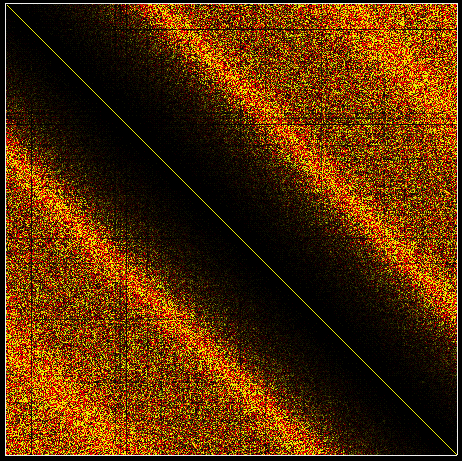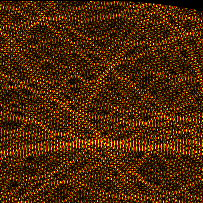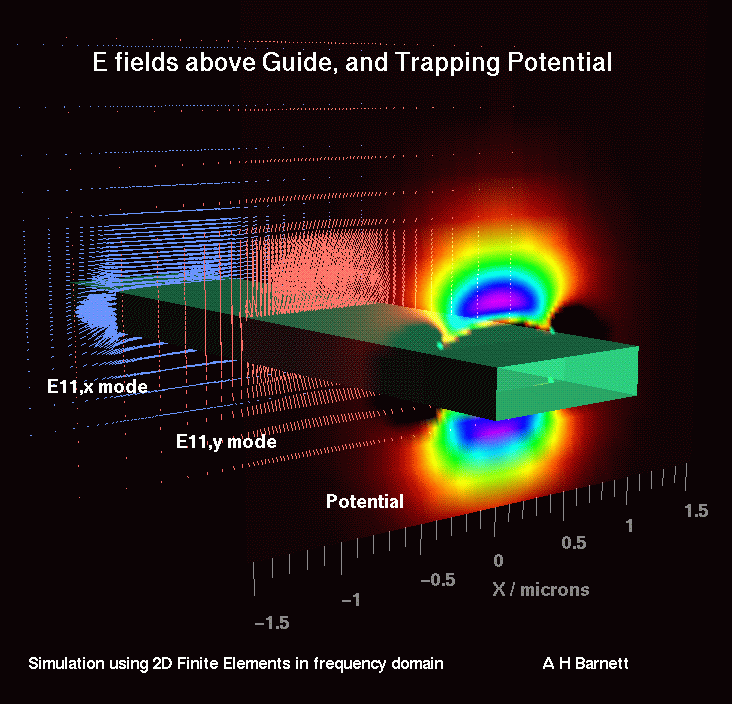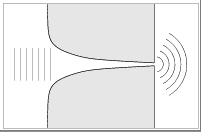Alex Barnett
PHYSICS RESEARCHHELLER GROUP 1996-2000

Lyman 429, tel (617) 496-4013.
By physical mail:
Department of Physics
Harvard University
Jefferson Labs, 17a Oxford St
Cambridge MA, 02138, USA.
Alex BarnettPHYSICS RESEARCHHELLER GROUP 1996-2000 |
 |
How to reach me (if you could go backwards in time):
Lyman 429, tel (617) 496-4013. By physical mail:
|
More about research topics...

If the cavity slowly changes shape, the particles can be heated in an irreversible manner due to random energy exchange with the moving walls - this dissipation happens in both quantum and classical mechanics. In work with Doron Cohen, we have discovered the fact that deformations which preserve shape have vanishing heating rates, and this led us to improve the `wall formula' estimate for heating rate. The dilation deformation case turns out to be crucial to the operation of an efficient numerical eigenstate method too.
I also study open systems: the conductance of electron or matter waves through arbitrary potential structures, for instance a quantum point contact coupled to an open resonant cavity. A scattering theorist's approach provides many insights which complement the traditional transmission matrix recipe (Landauer formula).
I have also designed and simulated a new neutral
atom waveguide, which uses the evanescent light field above a submicron
dielectric optical guide. This design is ideal for the exciting experimental
field of atom optics
`on a chip' (substrate). This also involved
numerical 2D eigenstate calculations - vector electromagnetic waves rather
than scalar waves.
Research in the Heller Group is always interactive, exciting and full of variety, mainly due to Rick Heller's own highly intuitive and non-competitive research atmosphere, and his constant flow of good ideas!

The rate of change of the hamiltonian with respect to a certain deformation of the billiard boundary forms a matrix M when written in the undeformed eigenbasis. The band profile (mean square matrix element as a function of distance away from the diagonal) of M has physical significance: it tells you the dissipation coefficient under periodic time-depenedent `driving' of the boundary, in the linear response regime (classically, and when this is a valid regime, quantum-mechanically too, see this). Also the local density of avoided crossings (for 1 deformation parameter), and diabolical points (degeneracies in the spectrum for 2 or more parameters), are directly related to the limit of the band profile close to the diagonal. I hope to extend the work of Berry, Wilkinson and Austin on diabolical points in real billiard systems (as opposed to random matrices). Note that avoided crossings also are a mechanism for (quantum) dissipation - however an entirely different one than linear response mentioned above.
Above I show M in the case of the deformation being dilation. Contrast this with M for a `generic', ie non-special, deformation (a wiggle along the boundary), shown here. (Both data are for the quarter stadium billiard, for all 451 eigenstates in the wavevector range 398 < k < 402). The special property that for dilation, the mean square matrix element vanishes as you approach the diagonal has been called quasi-orthogonality. It is the key to the method of Vergini & Saraceno (see below). Using a technique of Mario Feinberg, the mean square element can be estimated semiclassically, using a long classical trajectory. We have found that the special cases of dilation and translation have a 4th power law, and rotation a 2nd power law, for the mean square element as a function of distance from the diagonal. This result applies to a generic billiard - we see deviations from these power laws (or possibly very slow convergence) in the stadium billiard, we believe due to neutrally-stable orbits causing long-time correlations.
For more detail, see complete slides for my 3rd Feb 2000 group talk on this, or the paper (nlin.CD/0003018) on this work with Doron Cohen and Rick Heller.
 IMPROVED
`WALL FORMULA' FOR DISSIPATION RATE OF A DRIVEN CHAOTIC BILLIARD
IMPROVED
`WALL FORMULA' FOR DISSIPATION RATE OF A DRIVEN CHAOTIC BILLIARDThis work is in collaboration with Doron Cohen and Rick Heller. Download our paper... Rate of energy absorption for a driven chaotic cavity (nlin.CD/0006041).
 VERGINI
& SARACENO METHOD FOR DIAGONALIZING QUANTUM BILLARDS
VERGINI
& SARACENO METHOD FOR DIAGONALIZING QUANTUM BILLARDSI am working to extend Vergini's analysis of the
errors in this method, which arise from 2 causes: 1) the inability
of the basis to represent general solutions to the Helmholtz equation
at a single k value (without requiring exponentially large coefficients),
and 2) the deviation of the dilation matrix M from
the identity (M is the matrix studied above).
Vergini has made tremendous progress in creating a seemingly asymptotically-complete
basis set for the stadium billard - I am working on extending this to more
general shapes (using the three components: real plane waves, evanescent
plane waves, and Neumann-type Bessel functions), with Natasha Lepore.
The deviation of M from identity is responsible for the sixth-power
growth of tension errors, also found by Vergini, however, how this
power-law arises is under investigation.
 ATOMIC
TRAPS AND GUIDES USING DIELECTRIC OPTICAL WAVEGUIDES
ATOMIC
TRAPS AND GUIDES USING DIELECTRIC OPTICAL WAVEGUIDESIn brief, I implemented a non-uniform finite element solution for the full vector bound modes of a submicron dielectric optical waveguide, to assess its potential as an evanescent-field atom trap. For simplicity a rectangular guide was chosen, and the optimal trap design was found in the parameter space of height and width, under the constraint that the guide remain optically `single-mode' (ie one vertically and one horizontally polarized bound mode). By feeding red- and blue-detuned light down the guide with these 2 orthogonal polarizations, a stable potential minimum is felt by the atoms, due to the near-resonant dipole force. Trapped in the xy plane, they are free to travel in the z axis, and the device can operate in both incoherent and coherent regimes.
This work was chiefly in conjunction with Steve Smith (now at Draper Labs), Maxim Olshanii (now at USC), and Mara Prentiss of the Prentiss Group.
I have also worked on a new refractive index structure
for high-power single-mode erbium-doped fiber laser designs which allow
large mode area, with Mara Prentiss. This requires creating refractive-index
profiles that allow stable propagation of modes very close to optical cutoff
- two conflicting requirements.
 QUANTUM
POINT CONTACT MAXIMUM CONDUCTANCE, CROSS SECTION AND SCATTERING IN THE
HALF-PLANE
QUANTUM
POINT CONTACT MAXIMUM CONDUCTANCE, CROSS SECTION AND SCATTERING IN THE
HALF-PLANEA new radial basis set of partial-wave type states in the half-plane is appropriate to problems where usual `leads' cannot be defined (eg there are nearby scattering objects in the reservoirs, or the QPC is highly non-adiabatic). I develop this basis, and show it behaves just like usual transverse lead states as far as Landauer is concerned. It is also possible to express incident plane-waves in this basis, making connection with the cross section viewpoint. Furthermore, it furnishes scattering-theorists' analogies: a small hole in a wall is shown to be dominated by p-wave scattering and transmission. The p-wave transmission coefficient is found analytically using matching to the Laplace (k=0) solution local to the hole.
`Conductance' quantization of atom waves through a QPC has been recently proposed as an experiment by Joseph Thywissen of the Prentiss Group (now moving to Paris). I show that reciprocity of conductance (left-to-right = right-to-left) need not hold in such an atomic system, because there need not be a thermal occupation of incoming waves (the angular distribution may not be uniform).
This work is in conjuction with Miriam Blaauboer
and Areez Mody. Download our paper.